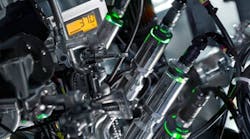OEM equipment forms the foundation of modern modular pharma manufacturing plants by providing the flexibility to choose and combine the best equipment solutions for specific processes.
Commissioning and validating OEM equipment is generally a faster process as manufacturers receive pre-assembled, purpose-programmed units. Furthermore, OEMs typically supply equipment in a validation-ready state, making it easy to qualify the equipment for use in CGMP facilities. There is no need to rely on internal resources or third parties for equipment construction and application code development.
However, challenges can arise from different connectivity standards and interfaces among various equipment vendors, making it difficult to integrate multiple pieces of equipment into a unified control system. This is where OEM equipment orchestration comes into play.
An orchestration strategy
Without a strategic approach and clear specifications, the use of OEM equipment results in fragmented islands of automation. This lack of a strategy is usually due to late collaboration with equipment vendors on the part of the end user. When automation is not considered in the initial equipment procurement process, engineers often struggle to integrate equipment or rely on engineering firms to handle the integration. At best, this late-stage process of piecing equipment together as an afterthought can lead to limited interface capability within the plant. At worst, the whole process can backfire by being time-consuming and costly with no increase in digital maturity.
To solve these issues, pharma manufacturers can adopt a holistic plan for OEM equipment orchestration to automate and coordinate various components to work seamlessly together early in the facility specification and design phases. Having comprehensive standards established before any equipment is purchased allows an end user to work collaboratively with equipment vendors, giving the OEM the opportunity to differentiate on how equipment can fit into a unified automation platform. For the end user, this simplifies cross-training and standardizes interfaces, alert systems, diagnostics and recipe management. This reduces costs, streamlines operations and results in faster construction, commissioning and qualification of the facility.
Standardized interfaces
End users are demanding OEM equipment that comes with plugand-produce capability to integrate with any distributed control system (DCS) or supervisory control and data acquisition (SCADA) system.
This plug-and-produce capability standardizes core automation services such as equipment interfaces and recipe management, user interface screens, audit trails and alarm management across disparate equipment. It systematically connects all these elements and coordinates them using standardized interfaces, like the NAMUR module type package, and modern protocols, like OPC Unified Architecture. Integrating all these disparate platforms together brings consistency, saves time and effort on integration, and makes plug-and-produce a feasible technology for facilities of the future.
These technologies should be viewed as an augmentation to a cohesive strategy for OEM orchestration rather than replacing all the work done with collaboration between organizations and comprehensive specifications.
Although there is no magic button to integrate equipment seamlessly, vendors can play a big part in an effective OEM orchestration strategy. For example, a plant built entirely with black box equipment with a standardized interface might be fast to integrate but would be difficult and costly for an end user to support long term due to managing numerous support contracts, disparate spare parts, and a lack of consistency in or access to application software on the OEM equipment.
A multitude of benefits
Put simply, the orchestration of OEM equipment facilitates the work of creating a unified automation platform for a facility. This ultimately leads to a faster time to market and lower total cost of ownership. Effective orchestration enables the integration of different OEM components in a way that allows for easy customization and scalability, new equipment addition into existing systems, and seamless integration of future upgrades and expansions.






